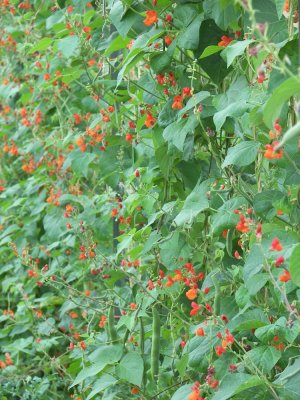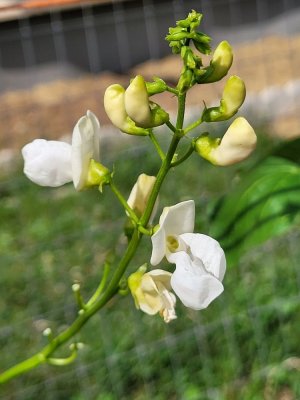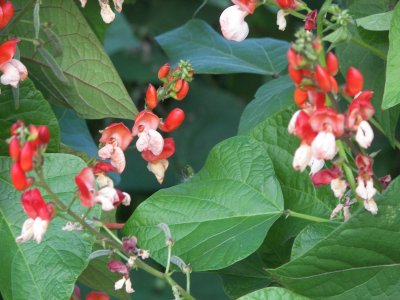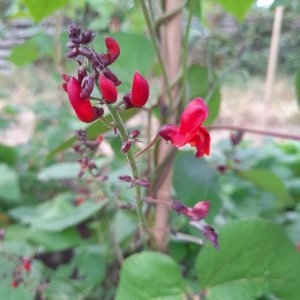You are using an out of date browser. It may not display this or other websites correctly.
You should upgrade or use an alternative browser.
You should upgrade or use an alternative browser.
2022 Little Easy Bean Network - We Are Beans Without Borders
- Thread starter Blue-Jay
- Start date
ducks4you
Garden Master
- Joined
- Sep 4, 2009
- Messages
- 13,247
- Reaction score
- 20,196
- Points
- 437
Every year, some of my yard gets away from me. THIS year, I really meant to clean up the street where there is old cattle fencing parallel to it, about 12 ft west. I thought that I had poisoned these saplings, but I guess not. Pretty sure that I will have it cleaned up by the end of August, but in 2023 I intend to do Some gardening there, plant a bunch of annuals (like my African daisies which will do Better with full sun, especially if I am able to harvest the seeds.)
I would like to sow scarlett runners there too, so it looks a lot like a flower garden to anybody who walks/drives by.
Of Course, I will try the produce for dinner and see if we like it as well as my bush beans that we are enjoying.
I would like to sow scarlett runners there too, so it looks a lot like a flower garden to anybody who walks/drives by.
Of Course, I will try the produce for dinner and see if we like it as well as my bush beans that we are enjoying.
Last edited:
HmooseK
Garden Addicted
There is only 1 variety I have grown. I got it from a fellow named Jim Wright if my memory serves me correctly. It’s called Insuk’s Wang Kong. Here’s a little story about them. I’m sure @Zeedman remembers this bean as a bunch of us used to hang out on Gardenweb in the bean forum. At one time The Sample Seed Shop sold these, but it went out of business when Remy passed away. I’m not sure where you can get them now. My seeds are pretty old as I only grew it once.Has anybody here had success with Scarlett Runner Beans?
The look very attractive and I know that they are tropical, and I live in temperate.
Any thoughts?
Insuk's Wang Kong - Beancyclopedia
Zeedman
Garden Master
When leaf yellowing starts, check the pods for yellowing. Cha Kura Kake is a very early soybean, so they are probably approaching maturity.... from what I can see in the photo, that appears to be the case. For edamame, I try to harvest them at the first sign of leaves or pods yellowing (or earlier if the seeds in the pods are fat). The harvest window for best-quality edamame can be very short, so plants should be checked often when pods begin to fill out... the beans inside should be fat, but mostly green. Once pod yellowing is widespread & the beans change color, the cooked beans become more like limas. I have to confess that I prefer to harvest Cha Kura Kake when the beans show a little of their two-tone coloration.This is Cha Kura Kake soy from @Zeedman - again I don't have my notes so apologies if I butchered the name. I'm not really sure what to think of the yellowing. They seem to have gone from "I've got little pods!" to "Well I'm done" overnight, though admittedly I've been working a lot so it was probably over a couple week span. I'd be interested in thoughts on this.

All soybean plants intended for use as edamame should be harvested at the same time, and the beans eaten or processed quickly; conversion of sugars to starch occurs within a day or two after harvest. Plants intended for seed should be watched closely when the pods begin to turn brown. Under some conditions, the dry pods can shatter, flinging their seeds on the ground. I've never experienced that with Cha Kura Kake, but it's worth keeping an eye on them just in case. Mice can harvest the seeds quickly once they are on the ground.
Zeedman
Garden Master
Has anybody here had success with Scarlett Runner Beans?
The look very attractive and I know that they are tropical, and I live in temperate.
Any thoughts?
Scarlet runner beans are very attractive in bloom; the flowers can be not only red, but white, pink, or bi-color. All are very attractive to hummingbirds.There is only 1 variety I have grown. I got it from a fellow named Jim Wright if my memory serves me correctly. It’s called Insuk’s Wang Kong. Here’s a little story about them. I’m sure @Zeedman remembers this bean as a bunch of us used to hang out on Gardenweb in the bean forum. At one time The Sample Seed Shop sold these, but it went out of business when Remy passed away. I’m not sure where you can get them now. My seeds are pretty old as I only grew it once.
Insuk's Wang Kong - Beancyclopedia
beancyclopedia.com



Left to right: Insuk's Wang Kong; Gigandes; Tucomares Chocolate
I am growing the white-flowered / white-seeded Gigandes this year. The vines will bloom anywhere; but are not really tropical... they prefer cooler, moderate temperatures to set seed. I grow quite a few runner beans in rotation, and even here, blossoms drop during hot weather. One day in the 70's though, and dozens of pods can set (we just had one of those cooler days today
 ). I seem to be in a "Goldilocks Zone" where I'm warm enough to grow limas, but get just enough cooler days in August to get seed from runner beans.
). I seem to be in a "Goldilocks Zone" where I'm warm enough to grow limas, but get just enough cooler days in August to get seed from runner beans.In warmer climates, getting seed from runner beans can be a challenge. Provided the season is long enough, they might set seed successfully in Autumn. If temps are in the 80's, spraying the vines with cool water several times a day during blooming sometimes sets a few pods (that might help you @ducks4you ). Insuk's Wang Kong appears to be a little more heat-tolerant than many runner beans, which is part of the reason for its popularity. Some of the varieties grown by indigenous peoples in the U.S. Southwest & northern Mexico (such as Tucomares Chocolate) are also more heat tolerant, but not as great for snaps.
I would describe runner bean snaps as "meaty". They do have a courser texture than common snap beans, which can be off-putting to some... but I like their sweet flavor. Varieties bred in the U.K. (where runner beans flourish) can be more suitable for use as snaps, but hard to find on this side of the pond. Regardless of variety, DW & I would harvest a couple pickings of pods just before frost, when most beans are done, and cool temperatures sweeten the pods. There doesn't seem to be as much variation in taste between different varieties of runner beans, as there is in snap beans. There is WIDE difference in the beans cooked as shellies though. White-flowered runner beans are often grown for that purpose, and can have HUGE, delicious white shellies that rival the largest limas. Shellies of darker-colored runner beans can have stronger flavors. I haven't experimented with runner beans as dry beans; but in a good year, or in more suitable climates, the dry seed yield can be large.
Decoy1
Garden Addicted
Scarlet runner beans, Phaseolus coccineus, are traditionally the bean of choice in Britain, for eating as a green bean. My father, who grew only the one vegetable, grew runner beans every year. He had a trellis which remained in place at the bottom of our garden and the beans were his pride and joy. He was very typical of of English growers.
They usually need to be de-stringed round the edges, often with a potato peeler, and then they’re often sliced quite thinly. I love them and they’re still my favourite bean. Traditionally a very popular variety has been Scarlet Emperor but there have been many, more recent additions to what is available, some of which are higher yielding.
As Zeedman says, they prefer cooler, damper conditions than what have traditionally been called French beans in England (Phaseolus vulgaris). Cooler, damper conditions are what the English climate has been able to offer them. Alas, at the moment, and possibly never again, in much of England this is no longer so!
They usually need to be de-stringed round the edges, often with a potato peeler, and then they’re often sliced quite thinly. I love them and they’re still my favourite bean. Traditionally a very popular variety has been Scarlet Emperor but there have been many, more recent additions to what is available, some of which are higher yielding.
As Zeedman says, they prefer cooler, damper conditions than what have traditionally been called French beans in England (Phaseolus vulgaris). Cooler, damper conditions are what the English climate has been able to offer them. Alas, at the moment, and possibly never again, in much of England this is no longer so!
flowerbug
Garden Master
When leaf yellowing starts, check the pods for yellowing. Cha Kura Kake is a very early soybean, so they are probably approaching maturity.... from what I can see in the photo, that appears to be the case. For edamame, I try to harvest them at the first sign of leaves or pods yellowing (or earlier if the seeds in the pods are fat). The harvest window for best-quality edamame can be very short, so plants should be checked often when pods begin to fill out... the beans inside should be fat, but mostly green. Once pod yellowing is widespread & the beans change color, the cooked beans become more like limas. I have to confess that I prefer to harvest Cha Kura Kake when the beans show a little of their two-tone coloration.
All soybean plants intended for use as edamame should be harvested at the same time, and the beans eaten or processed quickly; conversion of sugars to starch occurs within a day or two after harvest. Plants intended for seed should be watched closely when the pods begin to turn brown. Under some conditions, the dry pods can shatter, flinging their seeds on the ground. I've never experienced that with Cha Kura Kake, but it's worth keeping an eye on them just in case. Mice can harvest the seeds quickly once they are on the ground.
also keep an eye out for chipmunks which raided them here as often as they could until i trapped them.
groundhogs eat the foliage, rabbits will too and of course deer. i don't grow these soy beans outside the fence. i managed it once and then no attempts after that ever got me much of a harvest.
ducks4you
Garden Master
- Joined
- Sep 4, 2009
- Messages
- 13,247
- Reaction score
- 20,196
- Points
- 437
REALLY?!? My research said that they are tropical, from Mexico.Scarlet runner beans, Phaseolus coccineus, are traditionally the bean of choice in Britain, for eating as a green bean.
Could we be talking about 2 different varieties?
Last edited:
Triffid
Deeply Rooted
ducks4you
Garden Master
- Joined
- Sep 4, 2009
- Messages
- 13,247
- Reaction score
- 20,196
- Points
- 437
Good to know. I should definitely look for a hybrid like yours that will do well in my growing zone. 



